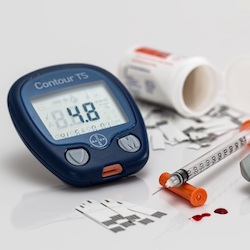While it is commonly accepted that free fatty acids (FFA) cause insulin resistance and hyperglycemia in obese individuals, which drives hyperinsulinemia. However, as this new research shows, hyperinsulinemia may be observed in subjects with normoglycemia. The authors suggest that this and other evidence supports the notion that the paradigm should be reevaluated.

Researchers at the University of Gothenburg, Sweden, have presented results that may change how type 2 diabetes occurs. The study, published in EbioMedicine, shows that free fatty acids (FFAs) in the blood trigger insulin release even at normal blood-sugar levels, without an overt uncompensated insulin resistance in fat cells. And, even more so, the researchers demonstrate the connection with obesity: the amount of FFAs largely depends not only on how many extra kilos of adipose tissue a person carries, but also on how the body adapt to the increased adiposity.
Extensive research is underway to clarify exactly what happens in the body as type 2 diabetes progresses, and why obesity is such a huge risk factor for the disease. For nearly 50 years, diabetes researchers have been discussing their version of the chicken-or-egg question: Which comes first: insulin resistance or elevated insulin levels?
The dominant hypothesis has long been that the pancreas steps up its insulin production because the cells have already become insulin-resistant, and blood sugar then rises. However, the results support the opposing idea: that it is the insulin that increases first.
Free Fatty Acids and Diabetes Progression
The study indicates that high FFA levels in the blood after the overnight fast raise insulin production in the morning. FFAs have long been part of the main research equation for type 2 diabetes, but it is now proposed that they also have another role: in progression of the disease.
For the study, researchers compared metabolism in adipose fat storing tissue among 27 carefully selected research subjects (nine of normal weight, nine with obesity and normal blood sugar, and nine with both obesity and progressed type 2 diabetes). For several days, they underwent extensive examinations in which they had samples taken under varying conditions. The researchers analyzed metabolism and gene expression in the participants’ subcutaneous fat, and the levels of blood sugar, insulin, and FFAs in their blood.
Free Fatty Acids Trigger Insulin Production
The researchers noted that people with obesity but not diabetes proved to have the same, normal blood-sugar levels as the healthy individuals of normal weight.
- In obese subjects with normal glycemia elevated circulating levels of FFA at fasting are the major metabolic derangement candidate driving fasting hyperinsulinemia.
- Elevated FFA in obese with normal glycemia were better explained by increased fat mass rather than by adipose tissue insulin resistance.
- These results support the idea that hyperinsulinemia and insulin resistance may develop as part of a homeostatic adaptive response to increased adiposity and FFA.
“Interestingly, the nondiabetics with obesity had elevated levels of both free fatty acids and insulin in their blood, and those levels were similar to or higher than the levels we were able to measure in blood from the participants with both obesity and type 2 diabetes,” says Emanuel Fryk, resident doctor specializing in general medicine and doctoral student at Sahlgrenska Academy, University of Gothenburg, who is one of the study’s first authors.
In collaboration with researchers at Uppsala University, he observed the same pattern in a population study based on blood samples taken from 500 people after an overnight fast.
“The fact that we saw a link between free fatty acids and insulin there too suggests that the fatty acids are connected with the insulin release, and contribute to increased insulin production on an empty stomach, when blood sugar hasn’t risen,” says Fryk, who nevertheless points out that the finding needs to be confirmed with more research.
Free fatty acids are found naturally in the bloodstream and, like glycerol, are a product of the body’s fat metabolism. In the subjects, the amount of glycerol released proved to be broadly the same per kilo of body fat, regardless of whether they were of normal weight, had obesity alone, or also had type 2 diabetes.
“Our hypothesis is that the free fatty acids increase in the blood because the adipose tissue can’t store the excess energy anymore. We believe, in that case, it could be an early sign of incipient type-2 diabetes. If our findings are confirmed when other research methods are used, there may be a chance that some specific fatty acids could be developed into biomarkers. But that’s a long way off,” Fryk says.
Lifestyle and Type 2 Diabetes
Diabetes is one of the most common diseases, with an estimated 500,000 people affected in Sweden. There are also a large number of undetected cases, since many with type 2 diabetes are not yet aware they are ill. Diabetics are at an increased risk for a number of serious conditions, such as cardiovascular disease (which may result in heart attacks and strokes).
“There are many factors that contribute to the progression of type 2 diabetes, but it’s our lifestyle that has, in absolute terms, the largest impact for most people. Our study provides another argument that the most important thing you can do to slow diabetes progression is to change your life style early in the progression of the disease, before blood glucose is elevated, Fryk says.
NOTE: A similar study also just published, shows a distinct dose-dependent relationship of FFA levels in insulin resistance, prediabetes and Type 2 diabetes in non-alcoholic fatty liver disease patients. Screening serum FFA levels in NAFLD patients would be valuable in preventing diabetes development. More on this here.
Click Here for Full Text Study




